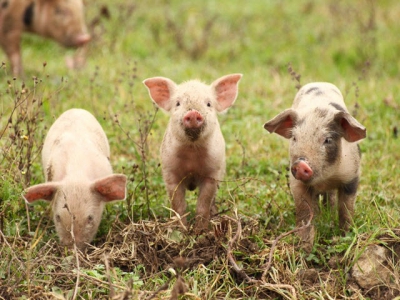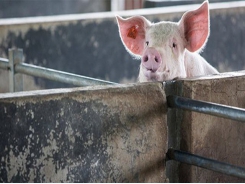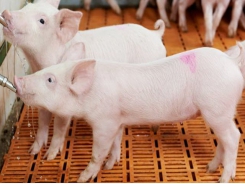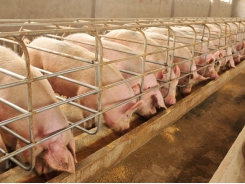US alternative hog producers focus on fiber, small grain use

Later weaning, high fiber diets and an emphasis on high feed quality are some of the elements involved in an alternative swine production system being modeled by some producers in the US.
Russ Kremer, manager of the Heritage Foods group and founder of the Ozark Mountain Pork Cooperative, has been part of groups producing heirloom hog breeds using an alternative production system with a focus on feed quality and sustainability.
Kremer has been expanding the scope of those production ideas through work with the Farmer Advisory Board at Palindromes Inc. and its subsidiary Hope Ventures, where he is CEO.
Palindromes is set to release a model for pork production later this year.
The international holding company has multiple interests including in agriculture and commodities and in supporting rural economies, according to company information. it wants to expand, to develop a series of smaller packing and processing facilities catering to smaller hog producers around the country, said Kremer.
“We find that in different regions in the US [producers] are interested in this model,” he told FeedNavigator. “Palindromes is going to facilitate that by creating some community-based, packing and processing plants that focus on creating highly differentiated, high-quality pork with the frills and the standards that consumers expect in various areas.”
Supporting the change in production
Such facilities would be smaller than many of those serving the conventional production system, and will have a focus on employee safety, energy efficiency and being environmentally conscious, said Kremer.
“They’ll be scattered around the US, particularly in areas where the hog concentration is less. It’s harder to raise hogs without antibiotics in areas where the population of hogs is very, very dense,” he added.
The heritage system has shown itself to be a viable one for the last 15 years and, in part, relies on a connected system of producers and consumers interested in supporting it, he said.
“Not only is this system replicable, but it’s scalable – this is supported by interest by pork producers primarily from new producers, young producers, out of the box producers who want to maintain some independence and make a living without having to produce 20,000+ hogs a year,” said Kremer.
“We’re setting forth a plan and within the next year launching our first community-based plant that will serve as a model for those to come,” he said.
“We’ve already identified in one area alone that there are as many as 95 farmers, particularly young farmers, who would want to take entire this type of production and keep it going.”
Production system background
Interest in producing hogs using a non-concentrated system started several years ago, said Kremer.
“We had the fallout of the pork commodity market that occurred in 1998/99 and we saw a mass exodus of pork producers especially in my county,” he added.
The current production practices were influenced by time spent in Europe studying the swine industry in several countries, he said. There was an interest in producer and consumer interaction that was not common in the US.
“We started a cooperative, a network of farmers and eventually personally made connections with major distributors,” he said. The group has worked with companies like Whole Foods, he added.
“The big premise of the model was producing hogs to the standard for producers willing to pay the price and to create a value chain to make money on every hog every year,” said Kremer. “At the same time, having a strategic consumer willing to pay the price to have the farmer do it that way – that model has been in place for about 10 years very, very effective.”
On the production side, piglets are weaned later, which reduces the need for expensive creep feeds, and appears to extend the production life of the sow, he said.
Piglet mortality has dropped below 1% and sows average about seven or eight parities.
Focus on feed, genetics
The focus on the use of higher quality feeds started early, said Kremer. More recently, this has included a move to only non-biotech feed ingredients.
“Our protocols before had been no antibiotics, all vegetarian feed, no other chemical additives so we became the prominent supplier in the US of the Non-GMO Project Verified pork,” he said.
The way to make the most of good genetics in the pig is to start with the feed, he added.
The work with Palindromes is a way to expand the network with other members of the agricultural industry, and the chance to access specialty soybean lines, he said.
“One of the pet peeves or qualms I have about the existing industry is we place so much emphasis on commodity rather than specialty and by that, I mean commodity feedstuffs are often put together on a least cost [basis] without paying much attention to how it affects the animal,” said Kremer.
The production system also focuses on using smaller grains like barley, oats, wheat and grain sorghum in the feeds, he said.
“On the soybean part, one of the things that we’re introducing now is high oleic soybeans to our rations – we’re doing a lot of preliminary research,” he added.
Although a specific ration or feed is not prescribed to producers taking part in the production effort, there has been a move away from using some ingredients like corn oil or dried distillers grains because of the types of fat they contain, he said.
The alternative production system also raises pigs without antibiotics, he said. Although they are treated individually if it becomes necessary – and then moved to a different production line.
A health challenge from an antibiotic-resistance pathogen raised questions for him about the way medications were used, he said. “It was a turning point that I could raise hogs without that,” he added.
“By using heirloom genetics, the right kind of feeds and, the right kind of production system – I became successful,” said Kremer. “I wanted to advocate to other producers that we be more judicious with our usage of antibiotics in livestock.”
Producers now start with the use of nutraceuticals like essential oils, probiotics and seaweed to support pig health, he said.
Additionally, the types of pigs favored tend to be those that can be raised with more roughage and fiber in their diets, he said.
“We feed barley and oats, we graze pastures and feed silages often,” he said. “We have farmers who are starting to feed more sprouted grains and have the genetics that can more fully utilize and handle more volume of those.”
Related news
Tools

Phối trộn thức ăn chăn nuôi

Pha dung dịch thủy canh

Định mức cho tôm ăn

Phối trộn phân bón NPK

Xác định tỷ lệ tôm sống

Chuyển đổi đơn vị phân bón

Xác định công suất sục khí

Chuyển đổi đơn vị tôm

Tính diện tích nhà kính

Tính thể tích ao




 How can the prenatal phase influence the lifelong…
How can the prenatal phase influence the lifelong…  Tweaking swine diets may alter GHG emissions
Tweaking swine diets may alter GHG emissions